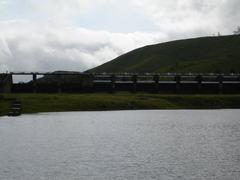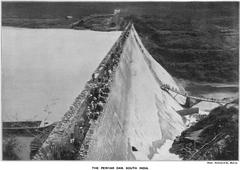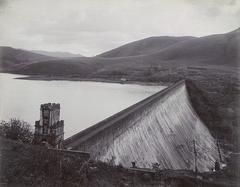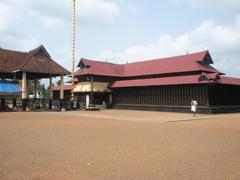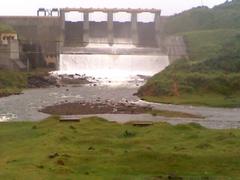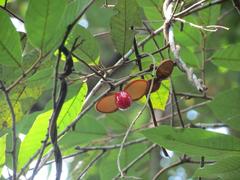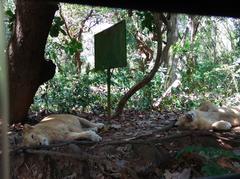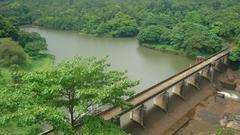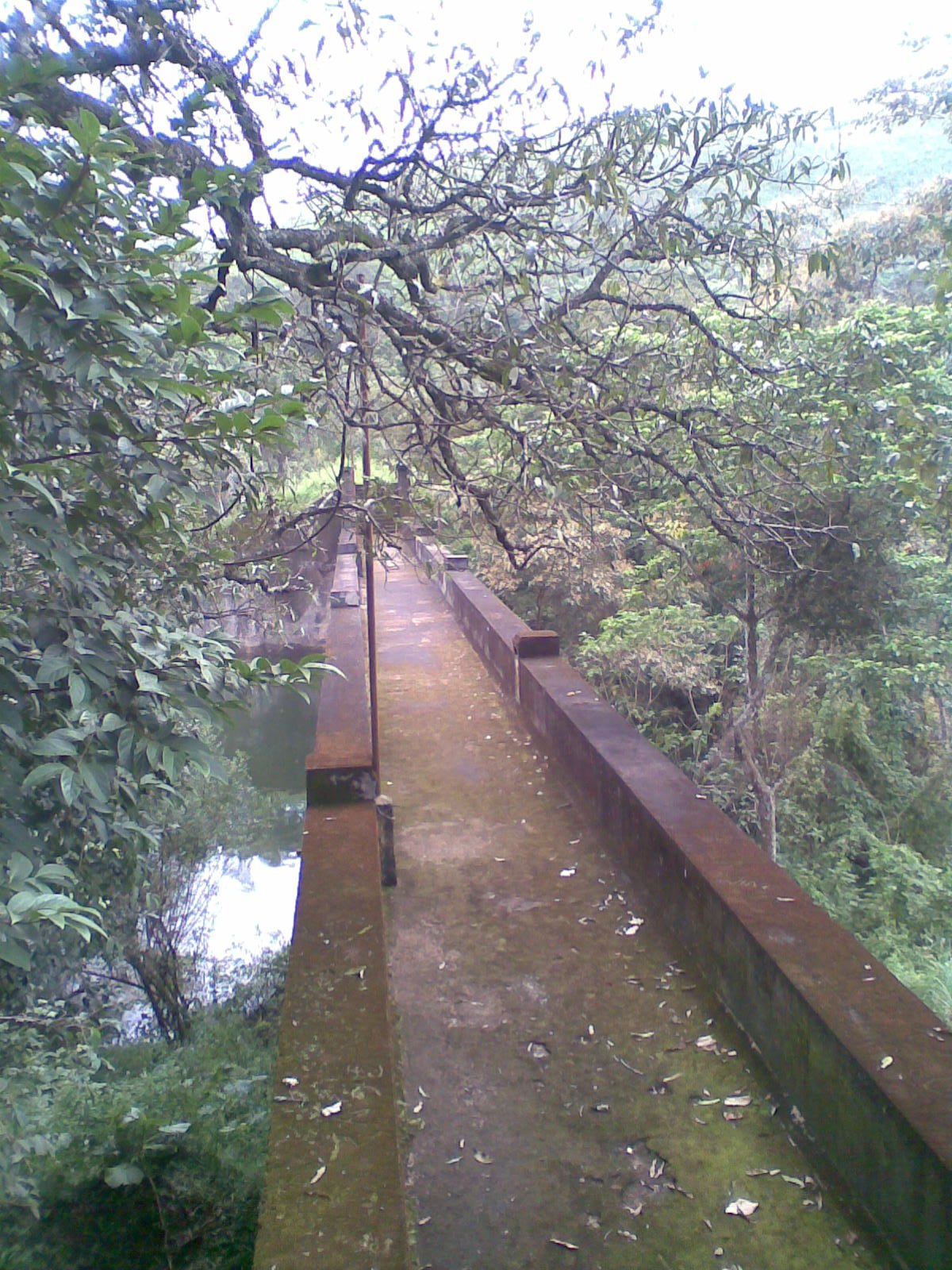
Mullaperiyar Dam Visiting Hours, Tickets, and Historical Significance Guide
Date: 14/06/2025
Introduction
The Mullaperiyar Dam, located amidst the lush Cardamom Hills of Kerala’s Western Ghats, stands as an extraordinary example of 19th-century engineering, entwined with rich ecological and socio-political significance. Completed in 1895 during British colonial rule, the dam diverts the waters of the Periyar River eastward into the arid plains of Tamil Nadu, supporting irrigation, drinking water, and hydroelectric needs for millions. Adjacent to the iconic Periyar Tiger Reserve and the vibrant towns of Thekkady and Kumily, the dam has become a popular destination for travelers intrigued by its history, stunning landscapes, and diverse wildlife.
This comprehensive guide provides essential information on Mullaperiyar Dam visiting hours, ticketing, accessibility, safety protocols, travel tips, nearby attractions, and historical insights. Whether you are a nature enthusiast, history buff, or a curious traveler, this resource will help you enjoy a safe and enriching visit to one of Kerala’s most unique landmarks.
Contents
- Historical Overview
- Visiting Mullaperiyar Dam: Hours, Tickets, and Accessibility
- Safety, Structural Concerns, and Oversight
- Environmental and Socio-Political Significance
- Things to Do and Nearby Attractions
- Practical Travel Tips
- Frequently Asked Questions (FAQ)
- Summary and Further Exploration
- Sources
Historical Overview
Engineering Marvel and Colonial Legacy
The Mullaperiyar Dam was constructed between 1887 and 1895 under the supervision of British engineer John Pennycuick. Rising to 53.6 meters and spanning 365 meters across the Periyar River, the dam was designed to channel water to Tamil Nadu’s drought-prone regions. This project revolutionized agriculture in Tamil Nadu by irrigating over 208,000 hectares and providing water security to countless communities (makemytrip.com).
The dam also formed the scenic Periyar Lake, now central to the Periyar Tiger Reserve, enhancing the region’s biodiversity and tourism appeal. Despite its location in Kerala, the dam’s resources are primarily managed by Tamil Nadu under a British-era lease renewed in 1970, making it a focal point of ongoing inter-state negotiations (The United Indian).
Visiting Mullaperiyar Dam: Hours, Tickets, and Accessibility
Visiting Hours
- General Hours: 6:00 AM to 6:00 PM daily (Holidify).
- Peak Seasons: October to March is ideal for visits due to pleasant weather. Monsoon season (June–September) may bring access restrictions due to safety concerns and heavy rains (Tripoto).
Entry Fees and Tickets
- Dam Premises: No entry fee for the general dam area. Parking charges (~₹20 per vehicle) apply.
- Boating on Periyar Lake: ₹25 per person; mandatory life jackets are provided.
- Guided Tours: Available through Kerala Tourism and local operators; prior booking is recommended during peak periods.
Accessibility
- By Road: The dam is 15 km from Kumily and 45 km from Thekkady. Private taxis and local transport are available.
- By Rail: Nearest major station is Kottayam (114 km).
- By Air: Madurai (140 km) and Kochi (190 km) are the closest airports.
- Onsite Facilities: Basic amenities are available; accessibility for visitors with mobility challenges is limited—advance inquiries are advised.
Safety, Structural Concerns, and Oversight
Structural Safety
Constructed using lime-surkhi mortar, the dam is over 130 years old and situated in a seismically active region (ClearIAS). Kerala authorities and independent studies have raised concerns about possible seismic vulnerability, siltation, and aging infrastructure (The United Indian). Tamil Nadu, which operates and maintains the dam, emphasizes ongoing reinforcement and Supreme Court-mandated safety measures.
Oversight and Regulation
The 1970 lease agreement and subsequent Supreme Court rulings (notably in 2006, 2010, and 2014) have established operational parameters and water levels, now monitored by the National Dam Safety Authority (NDSA) (Mathrubhumi). A new seven-member committee, led by the NDSA chairman, has been tasked with real-time monitoring of dam safety and reservoir operations (Onmanorama).
Safety Guidelines for Visitors
- Follow all posted instructions and avoid restricted areas.
- During monsoon, check for updates on accessibility and weather advisories.
- Life jackets are mandatory for boating; heed all staff directions.
- Maintain a safe distance from water bodies and wildlife.
Environmental and Socio-Political Significance
Ecological Impact
The dam’s reservoir submerges parts of the Western Ghats, a UNESCO World Heritage site and one of the world’s richest biodiversity hotspots. Changes in water flow impact the Periyar Tiger Reserve’s habitats, affecting tigers, elephants, Indian bison, and endemic flora and fauna (sajeevdev.com). Controlled water releases influence downstream river ecology and local livelihoods.
Inter-State Disputes
The dam is central to ongoing disputes between Kerala and Tamil Nadu. Kerala prioritizes public safety and environmental conservation, advocating for either a new dam or additional safety measures. Tamil Nadu emphasizes the dam’s essential role in water supply and agriculture (change.org).
Things to Do and Nearby Attractions
Walking, Sightseeing, and Photography
- Enjoy panoramic views of the dam, Periyar Lake, and surrounding hills.
- Colonial-era architecture and informative signboards provide historical context.
- Early morning and evening offer the best light for photography.
Boating on Periyar Lake
- Boating sessions run from 10:00 AM to 6:00 PM.
- Wildlife sightings, including elephants and birdlife, are common from the boat (Holidify).
Wildlife and Nature Activities
- Periyar Tiger Reserve: Offers trekking, bamboo rafting, night jungle patrols, and guided nature walks (Tusk Travel).
- Guided Tours: Engage tribal guides for immersive ecological and cultural experiences.
Cultural and Historical Sites
- Mangala Devi Kannagi Temple: Ancient hilltop temple, accessible during the Chithra Pournami festival (Tripoto).
- Spice Plantations: Guided tours through cardamom and pepper farms.
- Tribal Heritage Museum: Learn about indigenous Mannan and Paliyan cultures.
Thekkady and Kumily
- Stay in eco-lodges, forest cottages, or resorts in Thekkady and Kumily.
- Experience Kerala cuisine and vibrant local markets.
Practical Travel Tips
- Best Time to Visit: October to March for comfortable weather and clear views.
- Packing List: Light clothing, rain gear (during monsoon), comfortable shoes, sun protection, insect repellent, reusable water bottle, binoculars, and camera.
- Health & Safety: Carry personal ID, keep emergency contact numbers handy, and check for the latest updates on dam access and regional weather.
- Responsible Tourism: Respect wildlife, avoid littering, and support local communities by choosing eco-friendly tours and accommodations.
Frequently Asked Questions (FAQ)
Q: What are the Mullaperiyar Dam visiting hours?
A: 6:00 AM to 6:00 PM daily, subject to closure during monsoon or high water levels.
Q: Is there an entry fee or ticket required?
A: No fee for the dam area; parking and boating incur nominal charges.
Q: Are guided tours available?
A: Yes, nature walks and wildlife tours are available, often led by local guides.
Q: Is the dam safe to visit?
A: Regular monitoring is in place. Visitors must follow official advisories and safety guidelines.
Q: Can I stay near Mullaperiyar Dam?
A: Yes, Thekkady and Kumily offer a range of accommodations.
Summary and Further Exploration
Mullaperiyar Dam is a remarkable destination that seamlessly blends colonial engineering, ecological wonders, and the vibrant culture of the Western Ghats. By exploring its scenic vistas, engaging in wildlife activities, and understanding its complex history, visitors can appreciate both its beauty and significance. To ensure a safe and rewarding experience, follow all safety guidelines, choose sustainable tourism practices, and stay informed on the latest updates. For further information and planning resources, consult official tourism portals and download the Audiala app for real-time advice, maps, and guided content.
Sources
- Kerala Tourism Official Website
- MakeMyTrip – Mullaperiyar Dam
- The United Indian – Mullaperiyar Dam Controversy
- Holidify – Mullaperiyar Dam Sightseeing
- Sajeevdev – A Controversial Lifeline and Threat in Kerala
- Change.org – Sub Decommission of Mullaperiyar Dam
- Mathrubhumi – New Monitoring Committee for Dam Safety
- Onmanorama – Supervisory Committee for Dam Safety
- Thrillophilia – Thekkady Attractions
- Tusk Travel – Periyar National Park Planning
- ClearIAS – Mullaperiyar Dam Controversy
- Tripoto – Mullaperiyar Dam Travel Tips
- Rainwood Hotels – Thekkady Blog
- Kerala Orbit – Location and Accessibility
- Vajiram & Ravi – Kerala-Tamil Nadu Relations

